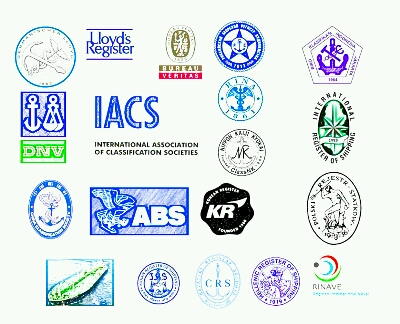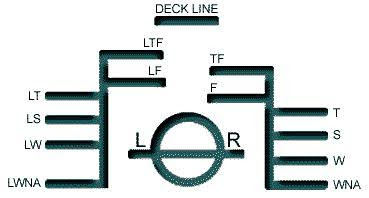 |
| classification society |
The ship classifications is activity aimed at classifying ship into the certain classes. A ship that already has classifications, required to continue to implement required survey to maintain class status. The types of the periodic survey are class renewal, annual survey, intermediate survey and docking/bottom survey. In addition survey are propeller shaft survey, boiler, machinery and other specialized surveys in accordance with classification society regulations. classification society will issue survey status and informed to the ship owner. A classification society is a non-governmental organization that established and maintains technical standards for the construction and operation ships and offshore structures.
Ship classification conducted based on the understanding that a ship loaded, operated and treated with the right way by a competent and certificated crew.The ship owner liable to ensure that vessel maintenance carried in a right manner until next periodic survey in accordance with requirements. The ship owner or their representatives also obliged to inform class surveyors when conducting a survey on ships, All events and condition which affect against class status.
History of classification society
History classification society started around in 1760, of a coffee shop owned by Edward Lloyd in London, at the time a coffee shop are mostly gathered people whose business relate to shipping services, sailors, ship owner until to the insurance. Until eventually arising the idea of Edward Lloyd to do recording ( registration ) against ships owner which often retired in his coffee shop.And from a list of the ship is finally a list of the ship was formed Lloyd's Register of Shipping ( LRS ) in 1760.
Firstly ships classified as class A, B, C and D in accordance with a condition on board based on with surveyor assessment which most of whom are the former ship captain. Eventually published first LRS rule, this rule is used as standard technically for ship classification and continued research and development in accordance with technology and development of shipping sector.
Now in this time has been also published also LRS rule for war ships. And LRS continue to grow up to now with various diversified technical inspection is not limited to the ship, but also facilities buoyant as FPSO ( Floating Production Storage and Offloading units ), FSO ( Floating Storage and Offloading units ), MODU ( Mobile Offshore Drilling Units ), platform and railway transportation, power generation and other industry then some classification society establish stand in another country like Bureau Veritas ( BV ) France in 1826, Det Norske Veritas ( DNV ) Norway in 1864 , Germanischer Lloyd ( GLLO )1867 in Germany, as well as several countries outside Europe such as japan with the establishment of Nippon kaiji kyokai ( class NK ) in 1899 and in the United States standing American bureau of shipping ( abs ) in 1862 .At the time it has been much-standing classification society in various countries who work primarily for flagged vessels or owned local owners.
Some of the classification society associated forming an International association called IACS ( International Association Classification Society ) that is one technically committee members of IMO. A member of IACS at this point is:
Lloyd' s Register of Shipping ( LRS ) stand 1760 London, England
Bureau Veritas ( BV ) stand 1828 in Paris, France
Registro Italiano Navale ( RINA ) stand 1861 in Genoa, Italy
American bureau of shipping ( ABS ) stand 1862 in Houston, United State
Det Norske Veritas ( DNV ) stand 1864 in Oslo , Norway
Germanischer Lloyd ( GL ) stand 1867 in Hamburg, Germany
Nippon Kaiji Kyokai ( NKK ) stand 1899 in Tokyo, Japan
Russian Maritime Register of Shipping (Российский морской регистр судоходства ) stand 1913 in st Petersburg , Russia
China Classification Society ( CCS ) stand 1956 in Beijing, China
Korean Register of Shipping ( KR ) stand in Daejeon 1960 , south Korea
classification society IACS members have a standard system procedure in basic pattern things as surveyors training, a ethics code and do so many things especially as regards operating procedure . To ensure system areapplied consistently by each members and IACS conduct audits at least once every year for every members.
Besides that more classification society in other countries off IACS organization, among other:
Hellenic Register of Shipping (HRS) stand in 1919 Pireus, Greek
Indian Register of shipping * ( IRS ) stand 1975 in Mumbai, India
Polish Register of Shipping (PRS) stand in 1936 di Gdańsk, Poland
Croatian Register of Shipping (CRS) stand in 1949 di Split, Croatia
Biro Klasifikasi Indonesia (BKI) stand in 1964 di Jakarta, Indonesia
Registro Internacional Naval (RINAVE) stand in 1973 di Paris, Perancis
Brazilian Register of Shipping (RBNA) stand in 1982 di Rio de Janeiro, Brazil
International Register of Shipping (IROS) in 1993 di Miami, Amerika Serikat
Iranian Classification Society (ICS) in 2007 di Tehran, Iran
Note: * associated member of IACS
classification society could be volunteered become members IACS, and then if audit results IACS said that classification society can be applied a the period during which classification society can be a member of temporarily before declared as permanent members. if a classification society which member of IACS found do unaccordance with the procedures IACS it can be applied sanctions that classification society is excluded from IACS member, of course, there is certain procedures and measurement of a degree of deviation specific that has been regulated internal IACS.
Statutory
Basically, the class is a very simple based on three main elements, applied for newbuilt phase and operational phase. - assigning standards (regulation classifications )
- According to the standard verification ( approval specifications and picture, surveys, and testing )
- document according to the standard survey ( report, certificates classifications ) classification society issue regulation with requirements for classifying and maintain the ship. Criteria application to rules classifications in some part arranged in part A to F in classification and regulations.
Part a: classification and survey apply to all kinds of vessels
part b: Hull and stability a ship
part c: system machinery
part d: material and welding
part e: notation service Naraku for sailing a ship.It was needed application more appropriate to define each chapter of the regulation
part f: additional notation class for a specific request or to all ships.
In calcified process started from Understanding regulation class classifications includes regulation, additional guidance and another document necessary of a ship.Then continued with pictures ratification process and calculation. If compliant calcified, will be published certificates for it.
Then in accordance with the provisions of classification, the ship periodically must be conduct inspection for purpose class holding. Classifications document is a document that cannot be changed or inviolable by parties or organization and classification society nor responsible for products, design or work other parties although some also relating to classification.
Some the schedule applied to survey each ship based on the time and the type of survey.
- Annual survey: a survey that performed annually and expired date when certificates issued.
- Intermediate survey: a survey that should be done every 2.5 years among class renewal survey of a ship.
- class renewal survey: class renewal survey every 5 years coincide with the end of the validity period for a shipping certificate.
- bottom survey: survey lower part of water line of a ship hull which conduct when dock every 2.5 years.
- tail shaft survey: a shaft propeller survey by depriving the shaft propeller conducted every 5 to 10 years
- boiler survey: boiler survey by opening and release all components boiler



